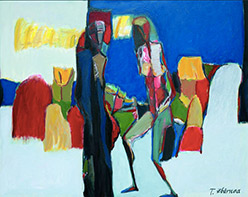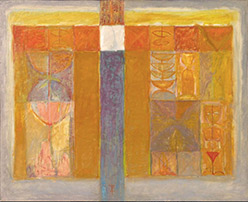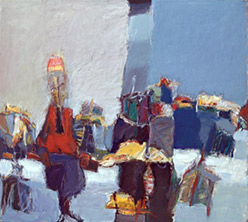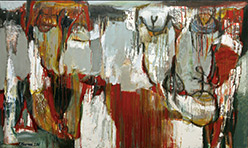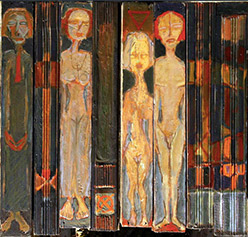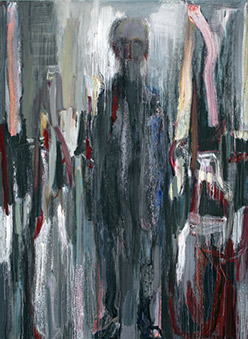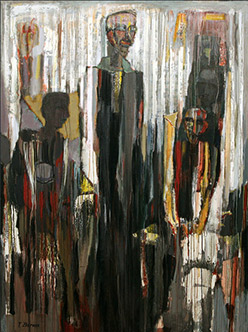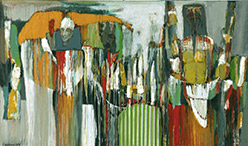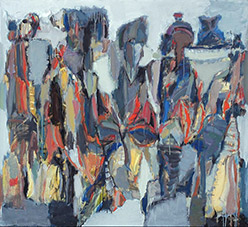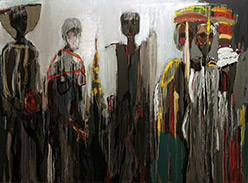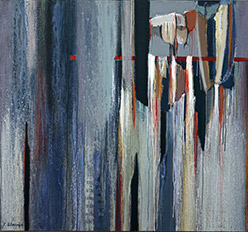Study and training:
National College of Fine Arts I.E.Repin, Chişinău
University of Arts George Enescu, Iasi (Romania), the Faculty of Fine Arts ,
Course – painting (prof. Corneliu Ionescu)
Consecration:
2018 Member of the European Academy of Sciences and Arts, Zalzburg, Austria
2017 Member of the National Academy of Arts of Ukraine
2009 Master in Art, Honorary Title awarded by the President of the Republic of Moldova
1990 Member of the Union of Artists of Moldova
1996 Member of the Union of Artists of Romania
1997 Member of the UNESCO International Association of Professional Artists
2001 Resident of Cité Internationale des Arts , Paris
1978 -1990 Painter - coordinator of the Academy of Sciences of Moldova
1990-1992 Deputy Head, Culture Department of Chisinau City Hall
1992-1994 Director of the Heritage and Visual Arts Department, Ministry of Culture of the Republic of Moldova
1994-2000 Lives and works in Bucharest.
Since 2002
is the Director General of National Art Museum of Moldova. During this
time at the museum, he did a lot to develop, protect, conserve and
expose national cultural heritage managed by the institution. Tudor
Zbârnea is appreciated for professional and intellectual probity and
moral integrity.
At the same time, he is in charge of many posts in national councils and commissions:
Chairman of the National council for monuments of public placement;
Chairman of the National commission for museums and collections within the Ministry of Culture;
Vice-chairman of the Council of experts to determine and establish artwork within the Ministry of Culture;
Chairman of the Council for strategic development of the Academy of Music, Theatre, and Fine arts.
Participates as chairman and member of jury at many national and international visual-art competitions.
Tudor Zbârnea
started and developed all time collaboration relations with many
museums and cultural institutions from abroad, coordinating diverse
exhibition visual-art projects, by this promoted Moldovan image abroad.
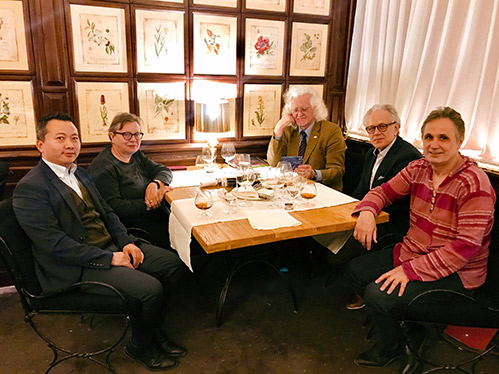
Photo left to right: OTGO Otgonbayar Ershuu (Artist, Chief Curator and External Affairs of the Mongolian National Art Gallery), Ewa Miazek
(Artist, president of association of Art Campaign, Poland), Dr.
Procopțov Vladimir (General Director at the National Museum of Art,
Belarus), Tudor Zbârnea (Artist, General Director of National Art
Museum of Moldova and Curator of the Biennial) and Simion Zamșa
(Artist, docent in fine arts, State Pedagogical University ‘‘Ion
Creanga’)
Jury–Team of The International Painting Biennial 2019
Organizers: National Museum of Fine Arts of R. Moldova; Union of Artists of Republic of Moldova; Art Center AMPRENTE
Is the author and curator of projects pertaining to visual arts:
- “Eastern neighbours”, Utrecht, Holland, 2006
- “Moldova, Contemporary Art” – Brussel, Belgium, 2006
- Founder and curator of International painting biennial, Chisinau – 2009, 2011, 2013, 2015, 2017
- “Moldova - Contemporary Art” – Moscow, Russia, 2012
- “Cultural extensions”, Mons and Brussels, Belgium, 2015.
Debuted in 1984
as part of the republican contemporary art exhibition organized in
Chișinău, from that year on he took part at almost all official
exhibitions organized by the Ministry of Culture and Union of Plastic
Artists of Moldova at home and abroad. Since 1992 he took part at a
number of exhibitions organized by the Union of Artists of Romania.
Took part at more than 350 representative exhibitions at home and abroad and organized 37 personal exhibitions.
Formed in the shadow of such great artists as Mihai Grecu, Dimitrie
Peicev and Andrei Sârbu, Tudor Zbârnea still at the beginning of his
career made clear his artistic profile, by which he became a strong
personality. The artist constructed tenaciously his own visual
expression, creating pictures where one can distinguish many steps of
aesthetical and imagistic order, at the same time kept the intact the
expressive function of color. Painting remains for him a form for
artistic research. The riddle being concentrated on existential
dimension, it tends to leave footprints on collective memory.
During his artistic career, Tudor Zbârnea represented Moldova abroad at
international art symposiums and salons, where he is distinguished by a
strong individual painting discourse (Belgium, Belarus, Czech Republic,
Cyprus, China, Kazakhstan, Finland, France, Georgia, Germany, Italy,
Lithuania, Holland, Russia, Slovakia, Turkey, Ukraine).
The artist’s creation being appreciated in media and specialized
literature by prestigious critics and art historians at home and
abroad: Constantin Ciobanu, Tudor Stăvilă, Tudor Braga, Ludmila Toma
(Moldova), Dan Grigorescu, Adrian Silvan Ionescu, Marin Gherasim, Tudor
Octavian, Pavel Șușară, Valentin Ciucă, Gheorghe Macarie, Iolanta
Malomen, Maria Bilasevschi, Aurel Chiriac, Negoiță Lăptoiu, Petre
Popescu-Gogan (Romania), Barys Krapak, Viktor Kovalev (Belarus),
Alberto Bolzonella (Italy) etc. His name is in many dictionaries and
art encyclopedias.
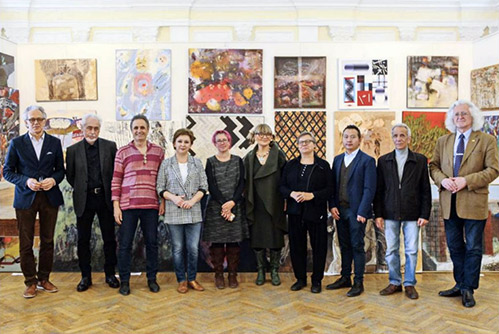 Photo
left to right: Tudor Zbârnea (Artist, General Director of National
Art Museum of Moldova and Curator of the Biennial), Ghenadie Jaloba
(Artist, Vice Chairman, Union of Artists from Moldova), Simion Zamșa
(Artist, docent in fine arts, State Pedagogical University ‘‘Ion
Creanga’), Svetlana Pociumban (Chief of Cultural Heritage at the
Ministry of Education, Culture and Research, Republic of Moldova), Dr.
Maria Bilașevschi (Art critic, chief of Cultural Program Bureau,
Cultural Center „Mihai Ursachi“, Iași, Romania), Dr. Hb. Tudor Stavilă
(Director of the Art museum adjacent to the Museum Compound “Moldova”
Iași, Romania), Ewa Miazek (Artist, president of association of Art Campaign, Poland), OTGO Otgonbayar Ershuu (Artist, Chief Curator and External Affairs of the Mongolian National Art Gallery),
Dr. Hb. Tudor Stavilă (Art critic and historian, Institute of
Cultural Heritage, The Ministry of Education, Culture and Research and
Chairman of Jury) and Dr.
Procopțov Vladimir (General Director at the National Museum of Art,
Belarus).
Photo
left to right: Tudor Zbârnea (Artist, General Director of National
Art Museum of Moldova and Curator of the Biennial), Ghenadie Jaloba
(Artist, Vice Chairman, Union of Artists from Moldova), Simion Zamșa
(Artist, docent in fine arts, State Pedagogical University ‘‘Ion
Creanga’), Svetlana Pociumban (Chief of Cultural Heritage at the
Ministry of Education, Culture and Research, Republic of Moldova), Dr.
Maria Bilașevschi (Art critic, chief of Cultural Program Bureau,
Cultural Center „Mihai Ursachi“, Iași, Romania), Dr. Hb. Tudor Stavilă
(Director of the Art museum adjacent to the Museum Compound “Moldova”
Iași, Romania), Ewa Miazek (Artist, president of association of Art Campaign, Poland), OTGO Otgonbayar Ershuu (Artist, Chief Curator and External Affairs of the Mongolian National Art Gallery),
Dr. Hb. Tudor Stavilă (Art critic and historian, Institute of
Cultural Heritage, The Ministry of Education, Culture and Research and
Chairman of Jury) and Dr.
Procopțov Vladimir (General Director at the National Museum of Art,
Belarus).
Jury–Team of The International Painting Biennial 2019
Organizers: National Museum of Fine Arts of R. Moldova; Union of Artists of Republic of Moldova; Art Center AMPRENTE
Research travel:
Belgium, Czech, China, Italy, France, Holland, Germany, Great Britain,
Georgia, Korea, Netherlands, Russia, Poland, Switzerland, Slovakia,
Turkey
Solo exhibitions:
2020
- Chisinau, National Art Museum of Moldova
2019
- Mihai Eminescu National Theater in Chisinau
- Academy of Sciences of Moldova
2018
- Bucharest, Romania, Roman Gallery
- Bacău, Romania, George Apostu Culture Center
2017
- Iasi, Romania, Art Museum
- Tallinn, Estonia, Art Gallery of National Library
2016
- Chisinau, Constantin Brancusi Gallery, Moldova
2015
- Oradea, Tara Crisului, Art Museum, Romania
2014
- Cluj-Napoca, Art Museum, Romania
- Sibiu, Brukenthal National Museum, Romania
- Ploiesti, Art Museum, Romania2012 - Odesa, Museum od Fine Arts, Ucraine
2011
- Gomel, Palace & Park Ensemble, Rumyantsev-Paskevich Palace
- Minsk, National Museum of Arts, Belarus
2010
- Chisinau, Constantin Brancusi Gallery, Moldova
2009
- Bucharest, Dialog Gallery,Romania
- Como (Schignano), Italy
2006
- Iasi, Museum of Arts, Romania
- Chisinau, Constantin Brancusi Gallery, Moldova
- Chisinau, World Bank Office, Moldova
2001
- Moscow, Exhibition centre Tsentral’nyi Dom Hudozhnica, Russia
- Paris, Cité Internationale des Arts, France
1998
- Brussels, World Exhibition Eureka-98, Belgium
1997
- Chisinau, Constantin Brancusi Gallery, Moldova
- Bucharest, Latin’s America House, Romania
1995
- Bucharest, Etaj – 3/4 Art Gallery, Romania
1994
- Piatra Neamt, Museum of Art, Romania
- Iasi, Victoria Art Gallery, Romania
1992
- Botosani, Stefan Luchian Gallery, Romania
- Bucharest, City Art Gallery, Romania
1991
- Chisinau, National Centre of Culture and Art, Moldova
1989
- Chisinau, Union of Writers of Moldova
1990
- Capo d’Orlando, de Florio Art Gallery, Italy
1988
- Chisinau , Art Salon of the Union of Artists, Moldova
1987
- Chisinau, State University Gallery, Moldova
1986
- Chisinau, City Gallery, Moldova
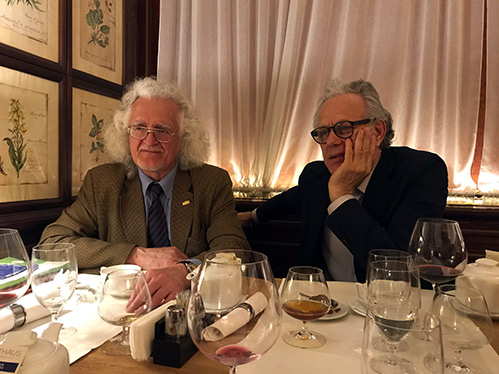
Photo
left to right: Dr. Procopțov Vladimir (General Director at the National
Museum of Art, Belarus) and Tudor Zbârnea (Artist, General
Director of National Art Museum of Moldova and Curator of the Biennial)
Jury–Team of The International Painting Biennial 2019
Organizers: National Museum of Fine Arts of R. Moldova; Union of Artists of Republic of Moldova; Art Center AMPRENTE
Relevant group exhibitions abroad:
2019
- Beijing, China, National Art Museum, Beijing International Art Biennale, edition 8
- Chisinau, Moldova, National Art Museum of Moldova, International Biennial of Painting
2018
- Bucharest, Centenary National Art Exhibition. National Museum of Art of Romania
- Castelfranco Veneto, Italy. Group exhibition (T.Zbarnea, E. Karacențev, S. Zamșa, I. Zderciuc)
- Piatra Neamț, Four for the Centenary. Group exhibition. Art Museum
2017
- Chisinau, Abstraction - form of freedom, C. Brâncuși Exhibition Center
- Strasburg, France, Council of Europe Office,
- Astana, Kazakhstan, International Exhibition of Contemporary Art,
- Beijing, China, National Art Museum, Beijing International Art Biennale, edition 7
- Chisinau, Moldova, National Art Museum of Moldova, International Biennial of Painting
2016
- Minsk, Belarus, Art Gallery M. Savitschi, International Exhibition of Contemporary Art
- Dreux, France, Art Gallery of the City Hall, International Exhibition
2015
- Beijing, China, National Art Museum, Beijing International Art Biennale, edition 6
- Dreux, France, Galery of Art of the Museum of History
2014
- Timisoara, Diplomatic Art, Romania
2012
- Rome, Museum of the Roman Civilization (Museo della Civiltŕ Romana), Italy
- Capo D’Orlando, Pinacoteca Tono Zancanaro, Italy
- Moscow, Rusia, All-Rusian Decorativ-Applied art Museum, Moldova.Contemporary art
2010
- Bucharest, Romania, Dialog Gallery
- Cannes, France, International Art Salon (Salon Grand Prix International de Prestige MCA de Cannes)
2009
- Cannes, France, International Art Salon(Salon Grand Prix International de Prestige MCA de Cannes)
- Moscow, Russia, International Exhibition of Contemporary Art ARTSALON-2009
2008
- Padua, Italy, La Renascence Gallery
2006
- Moscow, Russia, International Exhibition of Contemporary Art ARTSALON-2006
- Utrecht, Holland, International Art Salon
- Brussels, Belgium, Contemporary Art of Moldova, European Neighbourhood
2005
- Vilnius, Lithuania, Exhibition of Contemporary Art from Moldova
2002
- Moscow, Russia, Exhibition of Contemporary Art ARTSALON-2002
- Lyon, France, Exhibition of Contemporary Art from Moldova
1999
- Rome, Italy, Romanian-Italian Exhibition of Contemporary Art
1998
- Moscow, Russia, International Exhibition of Contemporary Art ARTSALON-98
1993
- Porto Sant’Elpideo, Italy, City Art Gallery
- Moscow, Russia, ARTMIF International Exhibition, MANEJ Art Gallery
1992
- Köln, Germany, City Art Gallery
1990
- Ficarra, Italy, City Art Gallery
1989
- Cyprus, Exhibition of Contemporary Art from Moldova
1988
- Finland, Exhibition of Contemporary Art from Moldova
1986
- Moscow, USSR, International Exhibition of Contemporary Art
1985
- Chisinau, Republican Exhibition of Contemporary Art in the Background of Peace. Central Exhibition Hall (Central Cathedral)
1984
- Chisinau, Republican Exhibition of Contemporary Art, Autumnala. Central Exhibition Hall (Central Cathedral)
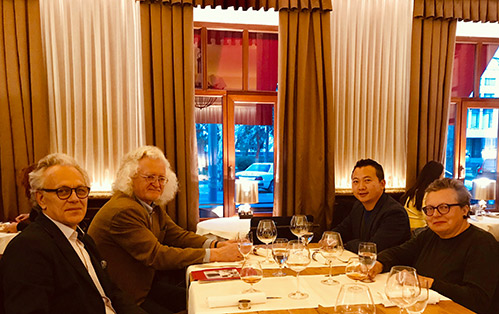 Photo left to right: Tudor Zbârnea (Artist, General Director of National Art
Museum of Moldova and Curator of the Biennial), Dr.
Procopțov Vladimir (General Director at the National Museum of Art,
Belarus), OTGO Otgonbayar Ershuu (Artist, Chief Curator and External Affairs of the Mongolian National Art Gallery) and Ewa Miazek
(Artist, president of association of Art Campaign, Poland)
Photo left to right: Tudor Zbârnea (Artist, General Director of National Art
Museum of Moldova and Curator of the Biennial), Dr.
Procopțov Vladimir (General Director at the National Museum of Art,
Belarus), OTGO Otgonbayar Ershuu (Artist, Chief Curator and External Affairs of the Mongolian National Art Gallery) and Ewa Miazek
(Artist, president of association of Art Campaign, Poland)
Jury–Team of The International Painting Biennial 2019
Organizers: National Museum of Fine Arts of R. Moldova; Union of Artists of Republic of Moldova; Art Center AMPRENTE
Honours and awards:
2021 - Prize of the Iulian Antonescu Museum Complex, Bacău, awarded during the exhibition - Moldovan Salons competition
2020
- Mihai Grecu Prize in the field of fine arts, awarded by the Ministry
of Education, Culture and Research of the Republic of Moldova
2019 - The Medal Mihai Grecu, awarded by Union of Artists of Moldova
2017 - Honorary title of Merited for Polish Culture
2016 - Award for Excellence in Art (TVR Awards, Gala of Moldova)
2016 - Ministry of Culture Prize: For work Memory in the National Fine Arts Competition
2016 - Diploma I-st Degree, the Government of Moldova
2016
- The Medal of the Academy of Sciences from Moldova, (nr.240) awarded
by the President of Academy of Sciences of Republic of Moldova
2016 - Second Prize for work Ascension in the exhibition Requiem, Union of Artists of Moldova
2016 - Gold Medal for Merit and French Devotion
2015 - Dimitrie Cantemir’s Medal, awarded by the Academy of Sciences of Moldova
2015 - Diploma I-st Degree, the Government of Moldova
2015 - Award of City Hall Bacau, Romania
2014 - National Award of Government of R.Moldova
2014 - Union Artist of Romania Award
2013 - Union Artist of R/Moldova Award
2010 - Winner of National Contest in Contemporary Arts
2010 - Grande Medalle d’Or, Salon Grand Prix International de Prestige MCA de Cannes
2009 - Grande Medalle d’Or, Salon Grand Prix International de Prestige MCA de Cannes
2009 - Honorary Title Master of Arts of Moldova
2009 - Diploma Ministry of Culture, National Contest in Arts
2009 - Trophy Vicolo Poldo, Como, Italy
2008 - Union of Artists of Moldova Award
2008 - Diploma Ministry of Culture, National Contest in Arts
2007 - Union of Artist of Romania Award
2005 - Diploma Ministry of Culture , National Contest in Arts, 1st edition
2002 - Prize of the Union of Artists for Painting
2001 - Prize of the International Cultural Centre G. Apostu , Moldova Salons contests
1998 - The Silver Medal at the World exhibition “Eureka” (Brussels)
1998 - Honorary Degree of the Flemish Artists Guild, Brussels
1997 - Honorary Degree of the European Art Academy, Brussels
1992 - “Lucian Blaga” Symposium award, Chisinau
1992 - “Moldova Salons” 2nd prize, Bacau, Romania
Public collections:
- Museum of Contemporary Art George Apostu, Culture Center, Bacău
- National Art Museum, Beijing, China
- National Museum Tara Crisurilor, Oradea, Romania
- National Art Museum Brukenthal, Sibiu, Romania
- Art Museum, Cluj-Napoca, Romania
- Art Museum, Ploiesti, Romania
- Art Museum, Iasi, Romania
- Art Museum, Sangeors Bai, Romania
- National Art Museum, Chisinau, Moldova
- Art Museum, Baia Mare, Romania
- Art Museum, Bacau, Romania
- Museum of A.Mateevici, Cainari, Moldova
- National Art Museum, Minsk, Belarus
- State Art Museum, Ankara, Turkey
- State Art Museum, Bishkek, Kyrgyzstan
- National Museum of Contemporary Art, Bucharest, Romania
- Collection of the Parliament of the Republic of Moldova
- Collection of the Romanian’s Embassy in Moldova
- Collection of the Agroindbank, Moldova
- Public Collection of Cannes City Hall, France
- Public Collection of Capo d`Orlando City Hall, Italy
- Public Collection of Focsani, Romania
- Collection of Union of Artists, Moldova
- Collection of Foundation STURZA, Moldova
Private collections:
Australia, Armenia, Austria, Belgium, France, Italy, Germany,
Kyrgyzstan, Moldova, Netherlands, USA, Romania, Russia, Slovakia,
Venezuela, Israel, Turkey, Finland, Cyprus, Lithuania
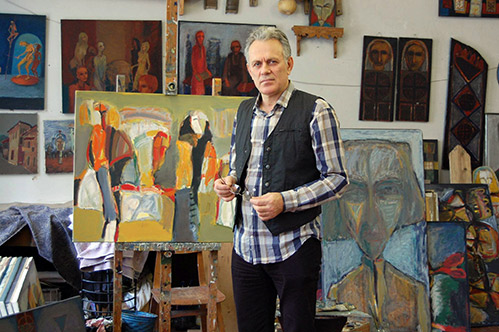 Tudor Zbarnea
Tudor Zbarnea
Criticism:
Tudor Zbârnea – Atemporal
Tudor Zbârnea is an artist who does not believe in the prejudice of
marginalization of art on the outskirts of Europe, opens with
self-assurance and elegance exciting painting exhibition, spectacular
visual shows all over the world. Director of the Art Museum of Moldova,
curator of the Chisinau International Biennale of Painting, with an
impressive history of enviable exhibits (guest of the art museums in
Ankara, Beijing, Minsk, Sibiu or part of the public collections of
cities like Cannes and Capo d’Orlando) Tudor Zbârnea is an artistic
personality of great refinement. On the picture rails of the Museum of
Art in Iasi, he exhibited to the public in Iasi the code for plastic
narrative and symbolic metaphors, at the same time in the form of
abstract-figurative syntheses, in which the elements of the attenuated
or diluted reality established a metaphorical order. “La pittura e una
cosa mentale”, and this principle is lived by Tudor Zbârnea through a
deepening of the previous artistic experiences, showcasing in each work
the dignity of the creative act and the professionalism.
The artistic creation consists of three stages, as Tudor Zbârnea
confesses, with a predominantly stylistic emphasis, but in which shape
and colour are subject to essential transfigurations. The content of
his images rises out from under the dominance of the boundless
figurative, being a pretext for a pseudo-rhetorical demonstration of
beauty not in the form of a configuration of expressive elements but
under the weight of the hope for a melding with the spirit and
emotional states of human sensibility. From heavy weight of the browns,
ochers, gold, gloomy colours expressing the attempt to balance matter
and spirit, gradual interventions on the structure that tended to be a
geometric composition, and has forced the reordering of forms and the
liberation of symbols in an instinctive way, it highlights a decanting
at the level of expression by installing the stylized human figure as a
binder between the two worlds. Tudor Zbârnea’s early painting does not
exclude the metaphorical allusion, the structures converting, through
intrinsic meditation, into systems of ideological metaphors. To the
very refined chromatic texture, the artist adds a whole ensemble of
meanings, swaying between two large nuclei, that of the tellurium, of
the shadow and of the spread of light, thus underlining the very
ambivalence of the human composition.
The flow of time, universal, mythical, and not least personal, in Tudor
Zbârnea’s works, reveals a great capacity for adapting the discourse
and framing the content according its own technical and conceptual
discoveries. Thus, the second period, reveals that in every geometric
incarnation is the experience of the space, of the time, of the
transmutated universality in particular. The point, the line, the
circle, the square, the geometric representations that lead to the
decipherment of the stylistic structure through the perception of the
atavistic sense, together with the chromatic contrasts: light, dark,
blue, red, white, create the impression of a geocentric world, an
ancestral communication system of cosmological thinking.
If apparently the painting of the artist at this stage displays a
controlled, elementary geometric rigor, gradually highlights that
within the rectangle or square, the gesture leaves a free trace, as if
at the will of chance, which emerges from a strong inner demand in the
virtue of which the oppositions are solved by complementarity. Thus,
these compositions of Tudor Zbârnea appears as a superposition, with a
personal touch, of harmonic syntheses with echoes in the rhythm of
traditional rugs or in medieval stained glass, which project the image
in a heterogeneity of symbolic symbols and Kandinskian type
expressionism, of chromatic vitality.
The artist uses pretexts from popular myths and rituals to invent a
personal mythology. Symbols such as the circle, the cross, are
extracted from the archaic, folklore, Romanian rituals and mysticism.
These motifs are a mediation between the ancestral abstraction of the
Romanian folkloric ornamentation and the modern non-figurative
abstraction. The created images align with both a conceptual direction
and an abstract one, but this polarization does not result in an
incongruent effect, but in a resemantization and a reloading of the
symbol.
According to previous norms about colour-form correspondences, the
square is associated with red, while the triangle is related to the
yellow range, but the artist is not tempted by the chromatic abundance
and the broad possibilities of derivation, machining, blurring, but by
the pure pictoriality, by the brightness of the same value. The centre
facilitates the inward passage from the temporal to the atemporal but
also the point where all the energies unify; the square is the symbol
of the tellurium and also of the divine space, while the cross becomes
a coagulating element of all the three, communion heaven - earth, space
- time. Under the sign of eternity, the elements are ordered according
to a geometric tale (ideally inspired by the secret geometry of the
Renaissance), freeing and guarding the composition of useless
decorativism.
In the last cycle of works, the structuring of forms does not result in
visual redundancy, but in a relationship of ontological autonomy in
which the plasticity of painting establishes the value of the feeling
of plenitude, in the robustness of the form, which has, paradoxically,
a hieratic character. The enveloping sensation of a peaceful
consistency emerges from the works, the atmosphere of lyricism removes
the artist’s expressionism from darkness, shadows, chimeras and
approaches the solar expression, the white light of divinity, healing
and reconciling. A certain volatility resulting from the blurring of
the tones, sometimes superimposed, sometimes juxtaposed, conjugates the
pictorial vision with suppleness.
In the “grey” phase, the artist pauses on the flavour of the matter,
the drawing incises form in a fluid mass that does not cancel the
two-dimensional, flat picture condition but transmits its own
significant load. Half realistic, half mystical, noble but without a
depreciative aristocracy of the human, the artist knows that the value
of the motif is the catalyst of a dynamic conception, the figurative
logic of the archetype is processed by the visual logic, making what is
proper to form to be absorbed in the visual sign.
The archetypal icons of Tudor Zbârnea are rooted in their own identity.
Tudor Zbârnea gives life through the paste to the archetype, which in
turn carries interrogations, nostalgias. Its characters, seemingly
without precise identity, capture the quintessence of the return to
introspection, the artist transgressing the figurative, the space
between the shapes being in turn a form. The rhythm is accentuated by
the repetition of forms, not autonomous in itself but subordinated to
physical, bodily constructions. In fact, this force gives to the entire
ensemble the dimension of human, human which exists in any temporal or
atemporal space, human that is the supreme attribute of knowledge.
The silhouettes and faces without identity create a range of characters
that express themselves through gestures, attitudes, postures, in an
atmosphere that conducts the thought to the Byzantine art in the sense
of a universe loaded with expressiveness. If you stop more in front of
the portraits, a clear “self-portrait” of a multi-millenary
interrogation is born on the retina. The mark of Tudor Zbârnea’s
cultural metaphor is that duality, between logic and abisal, between
expression and form.
Tudor Zbârbea does not force the boundaries of the viewer’s ability to
capture, beyond appearance, the core of the message, in a silent
partnership of intellectual complicity. Atemporal, out of history,
freed from terminological constraints, his style reflects the continued
interest in illustrating the essence of inter-human relations. His man
is him himself, a ladder between earth and heaven, through which he
advances to the celestial „white”. The artist has not abandon, during
the course of his evolution, the introspective character that in fact
provides him with the coherence and the authenticity of the discourse.
Dr. Maria Bilasevschi, Iasi, 2018
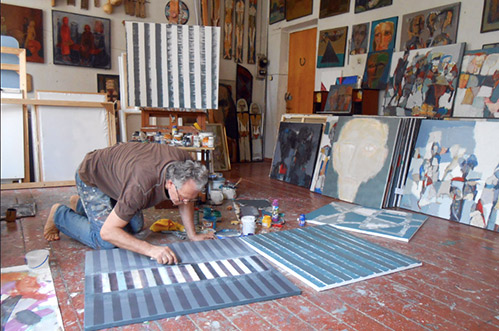 Tudor Zbarnea
Tudor Zbarnea
------------------------------------------------
TUDOR ZBARNEA AND THE IDEAL OF COMPLETENESS
Tudor Zbarnea makes part from that category of painters who examine by
means of art the aesthetics and ethics, the aesthetics organically
interweaved with the ethics in accordance with the Greek concept
Kalokagathon. A concept and ideal suggested also as an ideal for the
modern human being who has been frequently ignoring or rejecting the
idea of beautifulness in “favor” of expressiveness or even ugliness.
Kalookagathos, kalos kai agathos – Beautifulness is Goodness or, in other words, Goodness is Beautiful. It is beauty.
Tudor Zbarnea is one of those moralists, who are meditating on the
human being condition, but he makes it strictly through artistic means,
he makes it from within the imperatives of the image and not as an
additional speech to the image.
Expressionist tensions from some of his paintings are the expression of
his meditation on the human being in the world, especially of the
present day human being. This meditation is intimately blend with the
one focused on the nature of the painting.
In other words, we may say that his expressionism is one “well
tempered”. The artist does not use great distortions of the form, great
contrasts of colors or values. His painting is never grotesque, never
desperately crying, never gesticulating because of lack of hope. His
chromatics is severe but not somber. The painting is laid on the canvas
like on a wall, monastery wall. But let us remember that in the
religious iconography the hell is also present. As well as Last
Judgement, the possibility of Resurrection, Deisis.
In the subtext of his images we may guess sometimes the pattern of the
icon as a spiritualized form of organization of the image and the
elementary notion of the archaic configuration (the series of totemic
images with idols) when the painting becomes more stern, rougher.
Tudor Zbarnea is in an anxious search of himself, of the truth. His eye
is keenly directed towards the moral sense of the life
(“Disintegration”, “The utopia of the eternity or the truth of the
moment”, “Returning to himself”). At the same time he is a passionate
investigator of the expressive resources of the image that take place
in the huge space between expressionism and abstraction with symbolic
flavor.
“The second modernism” has begun to be talked about. In comparison with
the first, it is not proclaiming anymore “the absolute autonomy of the
image”, the image that finds its ultimate scope in itself, in its own
configuration but it is concerned by the insertion of the image in the
immense matter of the world, of the life.
In this respect, Tudor Zbarnea belongs to “the second modernism”.
MARIN GHERASIM, Bucharest, 2010
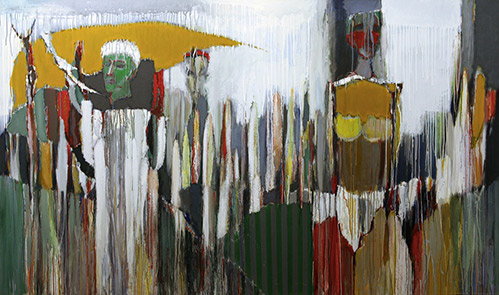 Memory path 2 by Tudor Zbarnea 2016. acryl on canvas 140 x 235 cm
Memory path 2 by Tudor Zbarnea 2016. acryl on canvas 140 x 235 cm
Collection of the Art Museum of CHINA
------------------------------------------------
Zbârnea’s painting feels like a descending on the golden genetic chain,
step by step closer to the treasure, an introspection within the self
taken as an “archeus”, it’s a retrovision, directly proportioned to the
depth of the descent to the origins. We are thinking at the origins of
the human, not “pro domo” and not necessarily and exclusively the
national (something like this doesn’t exist), but as an aspiration
towards the universal dimensions.
Petre Popescu-Gogan, Bucharest, 1996
------------------------------------------------
The colour is moulded masterfully, imagining bizarre vegetations,
mineralized or preserving the autumnal being, invigorated in portrait
by a vivacious patch of colour, discretely hidden from the view. The
paintings are a testimony of Tudor Zbârnea’s journey through the school
of maestro Mihai Grecu, a powerful “matierist” also preoccupied by the
genesis and by the continuous, slow sedimentation, by mineralization in
the end.
The characters directed by the painter live under the empire of a
planetary cataclysm and a tormenting sadness seeps from within,
becoming real.
The painter is a laborious spirit, illustrating a familiar
baudelaireian adage: “the more the matter presents itself in a positive
and solid way, the more the work of imagination is subtle and
laborious. The real is the soil where the artist plants not only
himself, but also the metaphor of his painting.
The light shed by the artist to things is here to remind us of the fact that the world itself was once just light…
Traian Mocanu, Iași,1994
 Martyrs by Tudor Zbarnea 2020. acryl on canvas 150 x 200 cm
Martyrs by Tudor Zbarnea 2020. acryl on canvas 150 x 200 cm
------------------------------------------------
Tudor Zbârnea reveals himself as an elevated, serious and laborious
spirit, in charge of his coherent and expressive artistic language. He
develops a subtle intertwinement between the marks of some ancestral
spirits, settled under the incidence of expressionist tensions and the
synthesis of some condensations of the chromatic paths in laconic
abstractizing reflections. He has long achieved that development state
where the union between ideational and affectional becomes an organic
and harmonious symbiosis. It’s also important to remark the pronounced
tendency of some emphasized illumination of surfaces through insertions
of ethereal “whites”, as a suggestion and a sincere desire to establish
a serene and pure climate.
Ancestral rhythms, Totemic axes, Between heaven and earth, Recourse to
the archetype. They are evocative references that recommend the
poignancy of some invocations of inspiring directions, harmonically
exploring the very essence of inter-human relations. He cultivates an
introspective genre of painting, concerning a tumultuous return to
memory. Regardless of the imaginative pretext, skilful and incisively
configured, the pictorial surfaces become animated.
Negoiță Lăptoiu Ph.D., Cluj – Napoca, 2014
------------------------------------------------
With an exceptional appetite for the infinitely remodelled paste, and
the same unpredictable associative appetite in composition, this
painting honours, through its amplitude, the potencies of this unique
tradition that dramatically survives on the both sides of the river
Prut.
By invigorating his vision once again, with well placed insertions from
the regional totemism, the Bessarabian is appealing for an integration
with contemporaneity. And he doesn’t do it anyhow, but with an
unmistakable articulation. He succeeds.
Val Gheoghiu, Iași, 2006
------------------------------------------------
Tudor Zbârnea is bringing into the spotlight the subject of the
immediate human existence and the pressures of the social as an effect
of historical collisions. With an expressionist hue so full of
emotional tension, the compositions dedicated to human drama always end
up as true portraits of dehumanization. Crushed by worries and needs,
the characters seem to be holding the weight of the world on their
shoulders, struggling with their Sisyphus efforts, devoided of any
meaning. In here I see the commentaries of a moralist who exorcises
through art restrained pains.
Valentin Ciucă, Iași, 2006
------------------------------------------------
I didn’t have nor do I think that I can have a direct engagement with
the issues of a concrete reality in my artistic discourse, from a
social point of view, but I am confident that, in truth, art is the one
that allows us to maintain the relation with the human. And for me, the
human condition in art is of foremost value. We cannot separate the
ethic from the aesthetic. We should always remain in a search for some
models, including moral ones. An artist, especially during the
incipient stages of development, cannot accomplish himself without
these guidelines.
TZ
------------------------------------------------
There is in the artist’s work a more folk Christianity than an official one, of ritual coding.
There is an evident air of rusticity, but filtered by a refined
intelligence which confers a note of authenticity, of an obvious
organicity seen at the level of the compositions and its symbols,
whether they are mysteriously encrypted or explicitly comprehensible.
Tudor Zbârnea is a colourist. While protean, his painting leaves a mark
on an entire universe of shapes and volumes, endowing them with
consistency and also with an integrative evanescence with everything…
The colours melt the outlines, eliminating the precise rigidity of the
line, soothing sharp square edges, making everything “atmospheric”. We
have in front of us a picture of ideas and also one of a certain
spiritual climate. Each brush of the paint, line, while in the making
or vigorously gestural, merges subtly with the same ambiance.
Gheorghe Macarie PhD, Iași, 2006
------------------------------------------------
Much like a reflection of byzantine iconography, the apparent rejection
of depth is here to visually signify the atemporal nature of spaces
Tudor Zbârnea paints. These are spaces of the human, in many cases
defending the characters, going from grotesque to apparently rest, and
from sensitivity to tragic. Not only the technique appears to be marked
by the one of byzantine icons, as I have previously stated, through the
presence of the characters but the subject itself is paradoxically
religious. In Tudor Zbârnea’s work we don’t encounter a classic eastern
religiousness but rather a history of a broad archetypal religiousness.
The works can be viewed as icons of intimacy of the human self and its
venture inwards and outwards the world.
Aurel Chiriac, Oradea, 2015
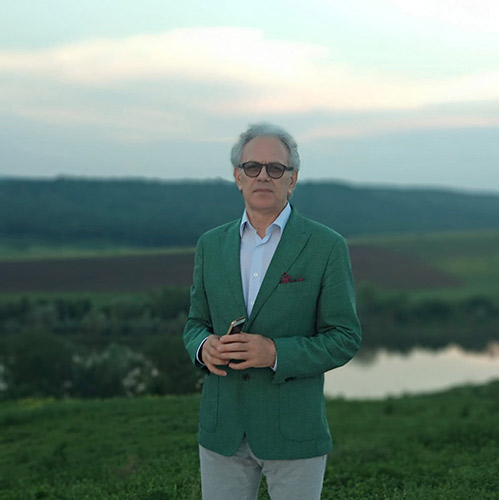 Tudor Zbarnea
Tudor Zbarnea

